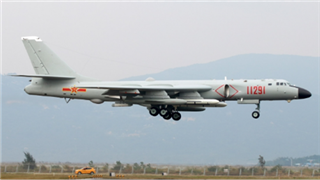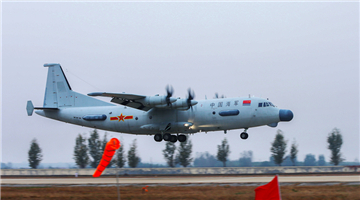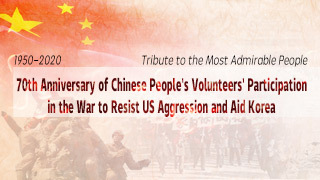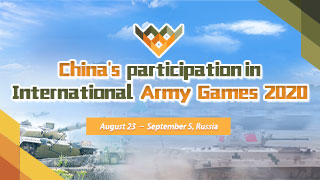The PLA Daily named the top 10 international military news in 2020 as follows on December 24, 2020.
NO.1 China releases first white paper on peacekeeping operations

On September 18, China released the white paper,China’s Armed Forces: 30 Years of UN Peacekeeping Operations, which comprehensively reviews the Chinese military’s contributions to the UN’s peacekeeping operations in 30 years, as well as its aspiration, mission, and policy stance.
This year marks the 75th anniversary of the foundation of the UN and the 30th anniversary of Chinese armed forces participating in UN peacekeeping operations. The first peacekeeping white paper released by the Chinese government fully demonstrates that the Chinese military is a staunch force safeguarding world peace and serving the building of a community of shared future for mankind.
NO.2 Militaries of China and Russia carry out pragmatic exchanges and cooperation

In June, the Chinese delegation attended the military parade marking the 75th anniversary of the Soviet victory against the Nazis in World War II at the Red Square, Moscow. In August, the Chinese military sent six teams to Russia to participate in the International Army Games (IAG) 2020. In September, Chinese troops participated in the Kavkaz-2020 strategic exercise in Russia. And in December, China and Russia signed a protocol on the extension of the agreement on notifications of ballistic missile and carrier rocket launches.
Military exchanges have been reduced due to the COVID-19 outbreak this year, but mil-to-mil communication and cooperation between China and Russia have maintained a good momentum, highlighting sound development of the China-Russia Comprehensive Strategic Partnership of Coordination for a New Era.
NO.3 Military game intensifies between Moscow and Washington

Russia and the US have had constant military frictions this year, represented by mutual interception of military planes and collision of military vehicles in Syria. What’s worth special attention is that the New Strategic Arms Reduction Treaty (New START) signed by the two countries in 2010 will expire in 2021, but the multiple rounds of talks held between Washington and Moscow this year on the extension of the treaty have failed to make breakthrough.
The constant military frictions reflect intensified military game between the US and Russia and bilateral tension. In case negotiations on extending the New START don’t reach a consensus when the deal expires next year, the international nuclear disarmament process will face a severe setback.
NO.4 US and Iran are on the brink of war

On January 3, the US military conducted the “targeted assassination” of Qassem Soleimani, Iranian major general and commander of the Quds Force, a wing of the Islamic Revolutionary Guard Corps (IRGC). On January 8, IRGC launched tens of missiles at an Iraqi military base stationed by US troops. On November 27, Iran’s top nuclear scientist Mohsen Fakhrizadeh was assassinated outside of Tehran.
The long-standing tension between the US and Iran is on the brink of an outburst this year, and their tit-for-tat operations have pushed the two countries to the edge of war.Washington’s military adventurism has violated the basic norms governing international relations and aggravated regional security situation and turbulence.
NO.5 A new round of conflicts break out in Nagorno-Karabakh

On September 27, Azerbaijan and Armenia engaged in a new round of conflicts in the Nagorno-Karabakh region, both accusing the other side of violating the truce agreement and starting military attacks. On November 9, leaders of Russia, Azerbaijan, and Armenia signed a statement announcing a full ceasefire in Nagorno-Karabakh starting at midnight that day, Moscow Time. Still, the two conflicting parties accused each other of violating the agreement after it came into effect.
The conflicts in Nagorno-Karabakh produced tens of thousands of refugees and seriously damaged regional peace and stability. Besides, the extensive use of UAVs preluded the future unmanned and intelligent warfare.
NO.6 “Deal of the century” cannot restore peace in the Middle East

On January 28, the US unveiled the Middle East Peace Plan dubbed as the “deal of the century”, which recognized Jerusalem as Israel’s “undivided capital”, confirmed Israel’s sovereignty over the Jewish settlements on the West Bank by allowing it full control in the region. After that, Palestine and Israel had multiple armed conflicts in Jerusalem and the West Bank.
The US-concocted “deal of the century” is neither just nor reasonable and is in no way helpful for the peace of the Middle East. To resolve the Palestine-Israel issue, the international community should insist on the “two-state plan” and abide by relevant UN resolutions and the internationally accepted “land-for-peace” principle.
NO.7 Divide between the US and its allies deepens

On July 29, the US announced its plan to withdraw 12,000 American troops from Germany and re-direct some of them to Poland. Besides, Washington has been pressuring the ROK multiple times this year to share a much larger proportion of the expenses of US troops stationed in the country, but rounds of negotiations have come to nothing.
America’s pressuring on its allies on the split of military expenses has caused widespread dissatisfaction among the allies. According to analysts, these moves are just new illustrations of the White House’s insistence on “America first” and unilateralism, which has deepened the divide between the US and its European and Asian-Pacific allies.
NO.8 Japan forms first Space Operations Squadron

On May 18, Japan officially established its first “Space Operations Squadron” at a ceremony held in Tokyo. As part of Japan Air Self-Defense Force (JASDF), the Squadron currently comprises about 20 personnel, although that number is expected to increase to about 100 in 2023 when the unit will realize full-scale operation. It will share information with Japan’s space aviation research and development agencies and the US military.
Japan has been promoting space militarization in small yet high-speed steps in recent years, with the establishment of the Space Operations Squadron, which reflects its pursuit for an advantageous position in the international game on this “high-altitude frontier”. Relevant developments in this regard have made the international community highly alert to space militarization.
NO.9 Afghan government and Taliban have the first face-to-face peace talk

On September 12, the Afghan government, Taliban, and other factions of the country began a peace negotiation in Doha, capital of Qatar. Abdullah Abdullah, chairman of the High Council for National Reconciliation, urged both sides at the kickoff ceremony to seize this rare opportunity and bring peace back to Afghanistan.
This was the first face-to-face peace talk between the Afghan government and Taliban, bringing a ray of hope to end the almost 20-year-long conflict in the country through political means. However, the negotiation was not plain sailing as the two sides had serious divergences on many core issues. The road to peace remains long and hard for Afghanistan.
NO.10 India shakes regional security situation by intensifying military deployments

The Indian military has continuously reinforced military deployments in the border region this year while taking over new weapons and equipment, including the Rafale fighter jets, and has stirred up conflicts with neighboring countries in Kashmir several times. India also joined the “Malabar 2020” joint exercise with the US, Japan, and Australia in the Indian Ocean in November.
At a time when the regional situation is complicated and sensitive and non-traditional security challenges like COVID-19 are escalating, India has chosen to stand on the wrong side of history by intensifying military deployment in the border region and forming “cliques”, which does nothing but a disservice to regional peace and stability.











